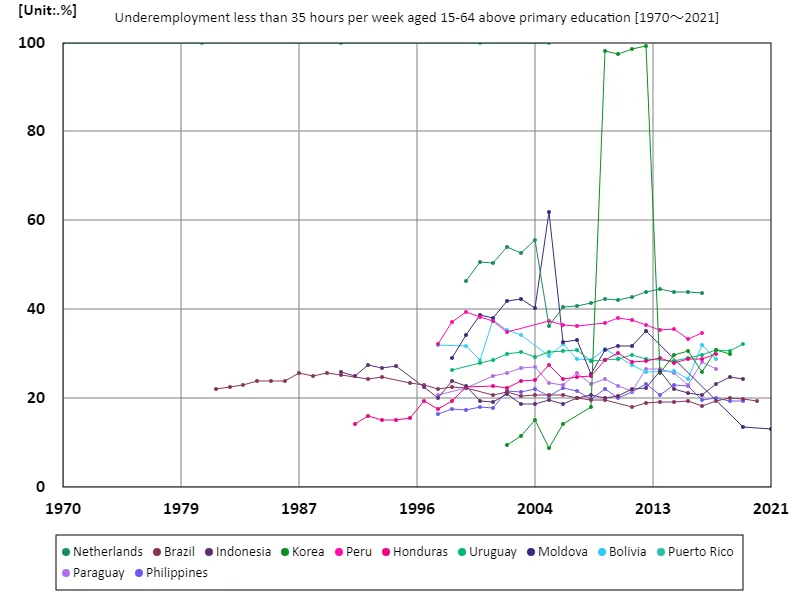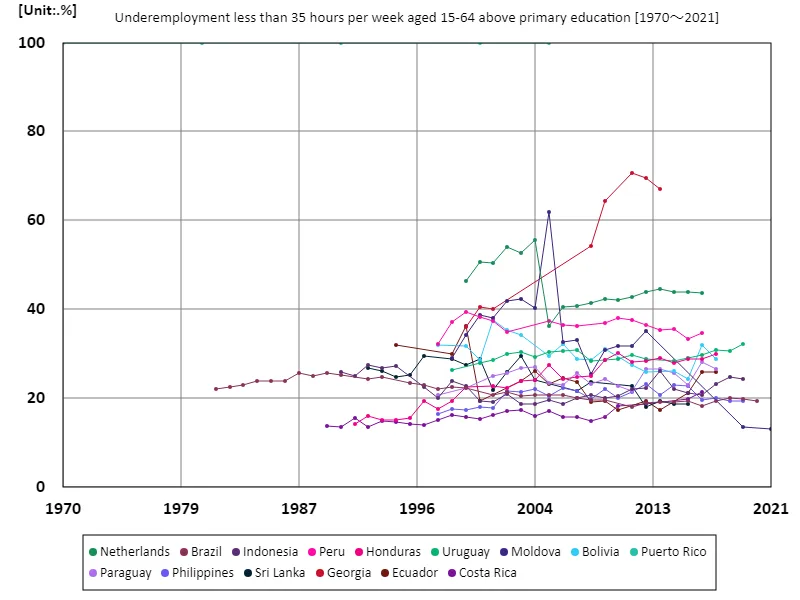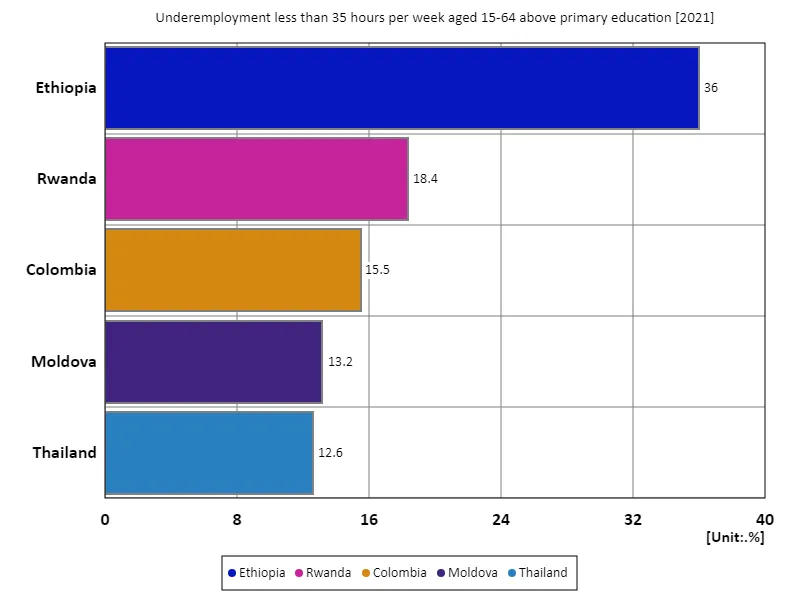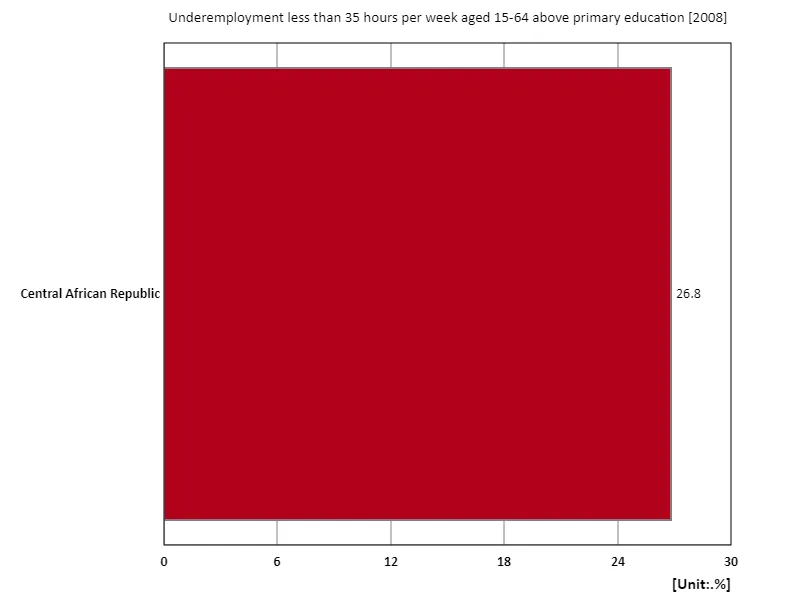- Abstract
- Ages 15-64, underemployed less than 35 hours per week, secondary education or higher (percentage of working-age population with tertiary education)
- Ages 15-64, underemployed less than 35 hours per week, secondary education or higher (percentage of working-age population with tertiary education) (Worldwide)
- Ages 15-64, underemployed less than 35 hours per week, secondary education or higher (percentage of working-age population with tertiary education) (World, latest year)
- Ages 15-64, underemployed less than 35 hours per week, secondary education or higher (percentage of working-age population with tertiary education) (region, latest year)
- Reference
Abstract
Employment underemployment is an important indicator that reflects the health of the economy and the dynamics of the labor market. According to 2021 data, Moldova recorded the highest rate of underemployment among its working-age population aged 15-64 with at least secondary education, at 13.2%, working less than 35 hours a week. This trend suggests economic instability, a lack of employment opportunities, and a job mismatch, especially for young people with higher education. As is the case in many countries, the higher the level of education, the wider the gap between job expectations and actual employment conditions tends to be, which can lead to social discontent and economic insecurity. The case of Moldova shows that economic recovery and growth requires creating decent employment opportunities, especially for a highly educated workforce.
Ages 15-64, underemployed less than 35 hours per week, secondary education or higher (percentage of working-age population with tertiary education)
Considering data from 1970 to 2021, Puerto Rico’s 100% underemployment rate of less than 35 hours is highly unusual. In particular, the fact that the entire workforce was underemployed in 1970 indicates economic difficulties and changes in the industrial structure. During this period, Puerto Rico faced a decline in manufacturing and economic stagnation, as well as increased immigration. Additionally, the fact that there are fewer workers with secondary education or higher entering the market compared to other regions highlights the mismatch between education and employment opportunities. Overall, societal challenges are growing, especially as educated workers continue to struggle to find the jobs they desire. Creating job opportunities and improving the quality of education are essential to a healthy labor market, and these efforts are required.


The maximum is 100%[1970] of Puerto Rico, and the current value is about 100%
Ages 15-64, underemployed less than 35 hours per week, secondary education or higher (percentage of working-age population with tertiary education) (Worldwide)
Looking at data from 1970 to 2021, Puerto Rico’s unique situation stands out: an underemployment rate of 100% for those working less than 35 hours. During this period, Puerto Rico faced a combination of problems, including economic stagnation, a decline in manufacturing, and increased immigration. In particular, the lack of suitable employment opportunities despite the large number of workers with secondary education or higher highlights the mismatch between education and the labor market. The employment situation in Puerto Rico is emblematic of the limited economic opportunities and lack of access to ideal jobs for young people. And similar trends are emerging in other regions, with a growing proportion of highly educated workers being underemployed. This shows the importance of quality education and vocational training, and improvements to the labor market are essential to revitalizing the economy across society. The current situation in Puerto Rico suggests that an urgent review of employment policies and economic strategies is needed, particularly measures to maximize the capabilities of educated workers.


The maximum is 100%[1970] of Puerto Rico, and the current value is about 100%
Ages 15-64, underemployed less than 35 hours per week, secondary education or higher (percentage of working-age population with tertiary education) (World, latest year)
According to 2021 data, Ethiopia’s underemployment rate for 15-64 year olds working less than 35 hours a week is 36%, the highest overall. This situation reflects the stage of economic development and the quality of employment, and indicates the reality that workers with secondary education or higher are particularly lacking in jobs. With an average underemployment rate of 19.1%, many countries face similar challenges. In many countries, including Ethiopia, there is a noticeable lack of decent employment opportunities despite the increasing availability of education. This suggests that economic growth is not keeping pace with improvements in education standards and highlights the need to expand employment opportunities for young people. In addition, underemployment of educated workers also affects economic efficiency and social stability, calling for improved employment policies. Overall, these data highlight structural problems in the labor market and indicate the importance of strengthening the link between education and employment and improving vocational training.


The maximum is 36% of Ethiopia, the average is 19.1%, and the total is 95.6%
Ages 15-64, underemployed less than 35 hours per week, secondary education or higher (percentage of working-age population with tertiary education) (region, latest year)
Data for 2008 show that the Central African Republic recorded an underemployment rate of less than 35 hours of work of 26.8%, the same as the overall average and total. The figures reflect the country’s economic difficulties and labor market instability. Despite the large number of workers with secondary education or higher, the lack of suitable employment opportunities illustrates the gap that exists between education and economic growth. High rates of underemployment are a widespread phenomenon, especially in developing countries, and suggest that higher education levels do not necessarily translate into better quality employment. It is believed that this situation is due to a mismatch between supply and demand in the labor market and a lack of policies to create jobs. The case of the Central African Republic also highlights the importance of economic stability and social development. In order to achieve sustainable growth, it is essential not only to improve the quality of education but also to create employment opportunities for young people that can utilize their skills. Future policies will require an integrated approach to education and employment.


The maximum is 26.8% of Central African Republic, the average is 26.8%, and the total is 26.8%



Comments